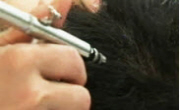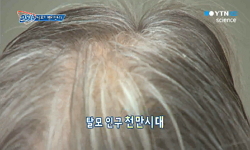스트레스는 탈모와 같은 피부질환의 주요 원인으로 알려져 있다. 스트레스에 대한 호르몬 반응은 corticotropin releasing hormone (CRH), adrenocorticotropic hormone (ACTH), cortisol 과 같은 호르몬으로 구성된 ...
http://chineseinput.net/에서 pinyin(병음)방식으로 중국어를 변환할 수 있습니다.
변환된 중국어를 복사하여 사용하시면 됩니다.
- 中文 을 입력하시려면 zhongwen을 입력하시고 space를누르시면됩니다.
- 北京 을 입력하시려면 beijing을 입력하시고 space를 누르시면 됩니다.
Corticotropin releasing hormone에 의한 인체 모낭 손상에서 산화 스트레스의 역할 = The role of oxidative stress in corticotropin releasing hormone - induced human hair follicle damage
한글로보기https://www.riss.kr/link?id=T15669722
- 저자
-
발행사항
포천 : 차의과학대학교 일반대학원, 2020
-
학위논문사항
학위논문(박사) -- 차의과학대학교 일반대학원 , 의생명과학과 바이오공학 , 2020. 8
-
발행연도
2020
-
작성언어
영어
- 주제어
-
발행국(도시)
경기도
-
형태사항
103 ; 26 cm
-
일반주기명
지도교수: 정지형
-
UCI식별코드
I804:41065-200000337116
- 소장기관
-
0
상세조회 -
0
다운로드
부가정보
국문 초록 (Abstract)
따라서 본 연구에서는 CRH에 의해 유도된 인체 모낭 손상에서 산화스트레스의 역할을 알아보고 인체 모낭과 그것의 구성세포에서 스트레스 환경으로 인한 항산화 방어 체계 변화에 대해서 평가하고자 하였다. 또한 백두옹 (Pulsatilla chinensis)으로부터 분리된 CRH 수용체 길항제의 보호효과에 대하여 알아보았다.
그 결과, 모낭의 구성 세포인 모유두세포 (dermal papilla cell, DPC)와 외모근초세포 (outer root sheath cells, ORSCs)에서 CRH와 CRH 수용체가 발현되며 CRH에 대해 반응하였다. CRH는 활성산소종의 과축적을 유도하며 G2/M기의 세포주기 억류 (cell cycle arrest)를 통하여 모유두세포의 증식을 억제시켰다. 또한 CRH가 처리된 모유두세포에서 성장기 관련 마커들의 발현을 감소시켰다. 흥미롭게도 CRH에 의해 POMC, ACTH, cortisol의 수치가 증가되며 이는 CRH 수용체 길항제에 의해 회복되었다. 게다가, 세포내에서 산화손상을 조절해주는 transcription factor인 Nuclear factor (erythroid-derived 2)-like 2 (Nrf2)와 그것의 downstream인 Heme oxygenase 1 (HO1), NAD(P)H dehydrogenase quinone 1 (NQO1)의 발현이 CRH를 처리하였을 때 증가되었다. 백두옹으로부터 분리된 CRH 수용체의 길항제는 모낭과 모유두세포에서 위와 같은 CRH에 의한 변화를 회복시켰다.
이러한 결과들을 종합해볼 때, 모유두세포에 완전한 HPA axis가 존재하고 스트레스 환경에서 CRH는 모낭과 모유두세포에 산화손상을 일으키며 직접적으로 영향을 미친다. 또한 CRH 수용체의 길항제는 스트레스성 탈모 치료를 위한 개선소재로써 사용이 가능할 것으로 생각된다.
스트레스는 탈모와 같은 피부질환의 주요 원인으로 알려져 있다. 스트레스에 대한 호르몬 반응은 corticotropin releasing hormone (CRH), adrenocorticotropic hormone (ACTH), cortisol 과 같은 호르몬으로 구성된 시상하부-뇌하수체-부신피질 축 (HPA axis)으로 인해 일어난다. 뿐만 아니라 다양한 스트레스 환경으로 생성된 활성산소종 (ROS)의 과축적은 세포의 사멸 혹은 노화를 유도한다. 대표적인 스트레스 호르몬인 CRH는 모발의 성장을 억제하고 탈모를 유도한다는 보고가 많이 있지만 세포 수준에서의 작용기전은 명확하지 않다.
따라서 본 연구에서는 CRH에 의해 유도된 인체 모낭 손상에서 산화스트레스의 역할을 알아보고 인체 모낭과 그것의 구성세포에서 스트레스 환경으로 인한 항산화 방어 체계 변화에 대해서 평가하고자 하였다. 또한 백두옹 (Pulsatilla chinensis)으로부터 분리된 CRH 수용체 길항제의 보호효과에 대하여 알아보았다.
그 결과, 모낭의 구성 세포인 모유두세포 (dermal papilla cell, DPC)와 외모근초세포 (outer root sheath cells, ORSCs)에서 CRH와 CRH 수용체가 발현되며 CRH에 대해 반응하였다. CRH는 활성산소종의 과축적을 유도하며 G2/M기의 세포주기 억류 (cell cycle arrest)를 통하여 모유두세포의 증식을 억제시켰다. 또한 CRH가 처리된 모유두세포에서 성장기 관련 마커들의 발현을 감소시켰다. 흥미롭게도 CRH에 의해 POMC, ACTH, cortisol의 수치가 증가되며 이는 CRH 수용체 길항제에 의해 회복되었다. 게다가, 세포내에서 산화손상을 조절해주는 transcription factor인 Nuclear factor (erythroid-derived 2)-like 2 (Nrf2)와 그것의 downstream인 Heme oxygenase 1 (HO1), NAD(P)H dehydrogenase quinone 1 (NQO1)의 발현이 CRH를 처리하였을 때 증가되었다. 백두옹으로부터 분리된 CRH 수용체의 길항제는 모낭과 모유두세포에서 위와 같은 CRH에 의한 변화를 회복시켰다.
이러한 결과들을 종합해볼 때, 모유두세포에 완전한 HPA axis가 존재하고 스트레스 환경에서 CRH는 모낭과 모유두세포에 산화손상을 일으키며 직접적으로 영향을 미친다. 또한 CRH 수용체의 길항제는 스트레스성 탈모 치료를 위한 개선소재로써 사용이 가능할 것으로 생각된다.
다국어 초록 (Multilingual Abstract)
The aim of this study was to examine the role of oxidative stress in CRH-induced hair follicle damage and identified the changes of antioxidant defense system in stress environments on human hair follicle and its cells. Also, the protective effect of CRH receptor antagonists from Pulsatilla chinensis (P. chinensis) was investigated on human hair follicles and human dermal papilla cells (DPCs) in vitro.
As a result, hair follicle cells, both human DPCs and human outer root sheath cells (ORSCs), expressed CRH and its receptors and responded to CRH. CRH inhibited the proliferation of human DPCs through at G2/M phase and induced the accumulation of ROS. Anagen-related marker levels were downregulated in CRH-treated human DPCs. Interestingly, increases in proopiomelanocortin (POMC), ACTH, and cortisol were induced by CRH in human DPCs, and antagonists for the CRH receptor blocked the effects of this hormone. Moreover, Nuclear factor (erythroid-derived 2)-like 2 (Nrf2), cellular oxidant regulator, expression levels were increased by CRH treatment in cultured human DPCs. And also, both Hemeoxygenase 1 (HO1) and NAD(P)Hdehydrogenase 1 (NQO1) expression levels were upregulated. Remarkably, CRH receptor antagonists isolated from P. chinensis reversed these CRH-induced modulations in both ex vivo hair follicles and cultured human DPCs.
The results of this study showed that a fully functional HPA axis exists in human DPCs and that CRH induce oxidative damages in human DPCs. Also, CRH directly affects human DPCs as well as human hair follicles under stress conditions. Additionally, P. chinensis effectively blocks CRH receptor function and that saponin derivatives from P. chinensis could be a pharmaceutical and cosmetic approach to treat stress-induced hair loss.
Stress is an important cause of skin disease including hair loss. The hormonal response to stress is due to the HPA axis, which comprises hormones such as corticotropin releasing hormone (CRH), adrenocorticotropic hormone (ACTH), and cortisol. In addi...
Stress is an important cause of skin disease including hair loss. The hormonal response to stress is due to the HPA axis, which comprises hormones such as corticotropin releasing hormone (CRH), adrenocorticotropic hormone (ACTH), and cortisol. In addition, hyperaccumulation of reactive oxygen species (ROS) produced by various stress environments is known to induce apoptosis or aging of cells. Accumulated reports have shown that CRH, a crucial stress hormone, inhibits hair growth and induces hair loss. However, the underlying mechanisms are still unclear.
The aim of this study was to examine the role of oxidative stress in CRH-induced hair follicle damage and identified the changes of antioxidant defense system in stress environments on human hair follicle and its cells. Also, the protective effect of CRH receptor antagonists from Pulsatilla chinensis (P. chinensis) was investigated on human hair follicles and human dermal papilla cells (DPCs) in vitro.
As a result, hair follicle cells, both human DPCs and human outer root sheath cells (ORSCs), expressed CRH and its receptors and responded to CRH. CRH inhibited the proliferation of human DPCs through at G2/M phase and induced the accumulation of ROS. Anagen-related marker levels were downregulated in CRH-treated human DPCs. Interestingly, increases in proopiomelanocortin (POMC), ACTH, and cortisol were induced by CRH in human DPCs, and antagonists for the CRH receptor blocked the effects of this hormone. Moreover, Nuclear factor (erythroid-derived 2)-like 2 (Nrf2), cellular oxidant regulator, expression levels were increased by CRH treatment in cultured human DPCs. And also, both Hemeoxygenase 1 (HO1) and NAD(P)Hdehydrogenase 1 (NQO1) expression levels were upregulated. Remarkably, CRH receptor antagonists isolated from P. chinensis reversed these CRH-induced modulations in both ex vivo hair follicles and cultured human DPCs.
The results of this study showed that a fully functional HPA axis exists in human DPCs and that CRH induce oxidative damages in human DPCs. Also, CRH directly affects human DPCs as well as human hair follicles under stress conditions. Additionally, P. chinensis effectively blocks CRH receptor function and that saponin derivatives from P. chinensis could be a pharmaceutical and cosmetic approach to treat stress-induced hair loss.
목차 (Table of Contents)
- Ⅰ. INTRODUCTION 16
- 1. Structure of human hair follicle 16
- 2. Corticotropin releasing hormone 19
- 3. Oxidative stress 21
- 4. Nuclear factor (erythroid-derived 2)-like 2 21
- Ⅰ. INTRODUCTION 16
- 1. Structure of human hair follicle 16
- 2. Corticotropin releasing hormone 19
- 3. Oxidative stress 21
- 4. Nuclear factor (erythroid-derived 2)-like 2 21
- 5. CRH receptor antagonists from P. chinensis 23
- 6. Aim of the study 23
- Ⅱ. MATERIALS AND METHODS 24
- 1. Human HF organ culture and hair cycle scoring 24
- 2. Primary cell culture and treatment 27
- 3. CRH treatment 29
- 4. CRH receptor antagonists 29
- 5. Cell proliferation 31
- 6. Apoptotic cell analysis 31
- 7. Cell cycle analysis 32
- 8. Measurement of intracellular reactive oxygen species (ROS) 32
- 9. Activities of antioxidative defense enzymes 32
- 10. Semi quantitative RT-PCR 33
- 11. Quantitative Real-Time PCR 34
- 12. Western blot analysis 36
- 13. Immunocytochemistry 36
- 14. cAMP assay 39
- 15. ACTH assay 39
- 16. Cortisol assay 40
- 17. Separation of cytoplasmic and nuclear extracts 40
- 18. Alkaline Phosphatase activity assay 41
- 19. Statistical analysis 41
- Ⅲ. RESULTS 42
- 1. Human DPCs express CRH receptors and respond to CRH 42
- 2. CRH inhibited proliferation through cell cycle arrest in cultured human DPCs 46
- 3. CRH induced ROS accumulation in cultured human DPCs 52
- 4. The expression levels of anagen-related markers were downregulated by CRH in cultured human DPCs 55
- 5. The local HPA axis in cultured human DPCs 57
- 6. CRH inhibited hair shaft elongation and induced early catagen transition in human HF organ culture 62
- 7. CRH induced early catagen transition was recovered by antioxidants 64
- 8. CRH induced the activation of Nrf2 signaling on cultured human DPCs 67
- 9. Cytotoxicity of compounds in human DPCs 75
- 10. Saponin derivatives from P. chinensis effectively blocked the CRH receptors 75
- 11. Saponin derivatives from P. chinensis antagonized CRH-induced damage in cultured human DPCs 78
- 12. Saponin derivatives from P. chinensis blocked MAPK signaling pathways 83
- 13. Saponin derivatives from P. chinensis protected cultured human HFs from the damaging effects of CRH 85
- 14. The natural materials elongated anagen stage in organ cultured human hair follicles 87
- Ⅳ. DISCUSSION 93
- Ⅴ. CONCLUSION 102
- REFERENCES 103
- ABSTRACT IN KOREAN 117









